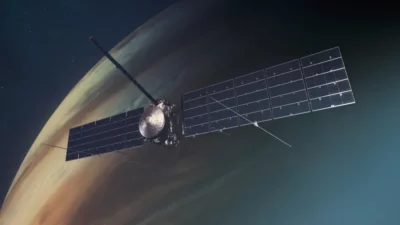In a move that’s sure to make conspiracy theorists’ tinfoil hats spin, NASA has officially launched its most ambitious alien-hunting mission to date. On October 14, 2024, at 12:06 p.m. EDT, the $5.2 billion Europa Clipper mission blasted off from Kennedy Space Center in Florida, riding atop a SpaceX Falcon Heavy rocket. This interplanetary expedition isn’t just a shot in the dark; it’s a carefully planned voyage to one of the solar system’s most intriguing destinations: Jupiter‘s icy moon Europa.
Why Is NASA Exploring Europa?

Why Europa? Well, it’s not because NASA’s GPS took a wrong turn at Mars. Scientists have long suspected that beneath Europa’s frozen exterior lies a vast ocean that could potentially harbor life. As Robert Pappalardo, a project scientist, put it, “We want to determine if Europa has the potential to support simple life in the depths of the ocean, beneath its ice layer.” In other words, NASA is hoping to find the universe’s ultimate hidden swimming pool – and maybe some extraterrestrial swimmers to boot.
“We want to determine if Europa has the potential to support simple life in the depths of the ocean, beneath its ice layer.” – Robert Pappalardo
NASA’s Biggest Interplanetary Probe
The Europa Clipper spacecraft is no slouch in the size department. Measuring over 30 meters long with its solar panels extended, it’s the largest interplanetary probe NASA has ever built. You might say it’s the Godzilla of space exploration, minus the city-destroying tendencies. This behemoth of a machine is set to embark on a 5.5-year journey, covering a mind-boggling 2.9 billion kilometers before reaching Jupiter’s orbit in April 2030.
Europa Clipper’s Mission
Once it arrives, the Europa Clipper won’t be content with just a drive-by photo op. The spacecraft is scheduled to perform at least 49 close flybys of Europa, swooping as low as 25 kilometers above the moon’s surface. In terms of interplanetary probes, that’s closer than most of us get to our in-laws during holiday dinners, and probably a lot more exciting.
The mission’s primary goal isn’t to directly search for little green men (or little blue ice men, in this case). Instead, it aims to assess Europa’s habitability. The spacecraft comes equipped with nine cutting-edge scientific instruments, including a radar system that can peer beneath the ice to explore the ocean below. It’s like an interplanetary X-ray machine, but instead of looking for broken bones, it’s hunting for the building blocks of life.
Europa is believed to contain twice the amount of water found in all of Earth’s oceans combined. That’s enough to make any conspiracy theorist sit up and take notice. If we do find life there, let’s hope it’s more “E.T. phone home” and less “Alien chest-burster.”
Mission Planing & Launch Challenges
The journey to launch wasn’t without its challenges. The Europa Clipper team faced personnel shortages, critical electronics issues, and even had to contend with Hurricane Milton. But as Jordan Evans, the project manager at NASA’s Jet Propulsion Laboratory, noted, “As Europa Clipper embarks on its journey, I’ll be thinking about the countless hours of dedication, innovation, and teamwork that made this moment possible.” It just goes to show that even when reaching for the stars (or in this case, Jupiter’s moons), it’s teamwork that makes the dream work.
Europa Clipper’s Mission Timeline
The Europa Clipper mission is expected to continue until 2034, potentially overlapping with the European Space Agency’s Juice mission, which is also en route to the Jupiter system. It’s like a cosmic meet-up, only with robots instead of humans, and with a lot more radiation.
As Nicky Fox, associate administrator of NASA’s Science Mission Directorate, enthusiastically stated, “We could not be more excited for the incredible and unprecedented science NASA’s Europa Clipper mission will deliver in the generations to come.” And who can blame her? The possibility of discovering extraterrestrial life, even in its simplest form, could revolutionize our understanding of the universe and our place in it.
So, as Europa Clipper hurtles through space on its epic journey, we earthlings are left to wonder: Will we finally answer the age-old question, “Are we alone in the universe?” Or will we just find a bunch of space ice cubes? Either way, one thing’s for certain – the next decade of space exploration is going to be out of this world.
Europa Clipper: NASA's High-Tech Hunt for Alien Life in Jupiter's Backyard #spaceexploration #alienhunting #jupitermission #europaclimper #nasaspacex Share on X










 Internet Archive Partially Resumes Operations After Cyberattacks
Internet Archive Partially Resumes Operations After Cyberattacks
Leave a Reply
You must be logged in to post a comment.